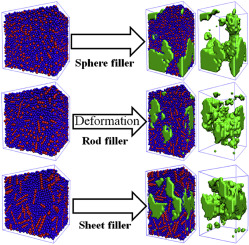Polymer ( IF 4.1 ) Pub Date : 2019-12-24 , DOI: 10.1016/j.polymer.2019.122103 Huan Zhang , Ruibin Ma , Dandan Luo , Wen Xu , Yunfeng Zhao , Xiuying Zhao , Yangyang Gao , Liqun Zhang

|
It is very crucial to understand the fracture mechanism of the polymer nanocomposites (PNCs) on the molecular level. In this work, the effect of the shape and size of nanofillers on it has been investigated in details by adopting a coarse-grained molecular dynamics simulation. First, the fracture energy of PNCs is found to be much higher for rod fillers than for sheet fillers and sphere fillers. Then it is reduced with increasing the nanofiller size much faster for sphere fillers than for sheet fillers and rod fillers which results from their interface and network. To better understand it, the bond orientation degree is characterized which can reflect the elongation. By calculating the stress contribution of matrix chains and nanofillers, the stress borne by matrix chains gradually decreases with the increase of nanofiller size for sphere fillers and sheet fillers while it is nearly same for rod fillers. In addition, the stress borne by sphere filler is gradually reduced with the nanofiller size while it borne by rod fillers and sheet fillers rises. The former is closely related to the number of the interfacial beads which bear the high stress while the latter is attributed to the stress contribution by the bond/angle energy. Furthermore, the number of voids is quantified which first increases and then decreases with the strain which reflects the generation and coalescence of voids. Meanwhile, the voids prefer to nucleate in the matrix which is a weak region at the strong interfacial interaction. Last, the maximum number of voids gradually increases with the nanofiller size for sphere fillers and sheet fillers while it is nearly unchanged for rod fillers which is consistent with the matrix region. In summary, this work could provide a further understanding how the nanofiller shape affects the fracture properties of PNCs.
中文翻译:

通过调整纳米填料的形状和尺寸了解聚合物纳米复合材料中的空化和开裂行为
在分子水平上了解聚合物纳米复合材料(PNC)的断裂机理非常关键。在这项工作中,通过采用粗粒度的分子动力学模拟,详细研究了纳米填料的形状和尺寸对其的影响。首先,发现棒状填料的PNC断裂能比片状填料和球状填料高得多。然后,随着纳米填料尺寸的增加,球形填料的填充量要比片状填料和棒状填料的填充量大得多,这是由于它们的界面和网络导致的。为了更好地理解它,对键的取向度进行了表征,可以反映出伸长率。通过计算基体链和纳米填料的应力贡献,球形填料和片状填料的纳米填料尺寸增加时,基体链所承受的应力逐渐减小,而棒状填料则几乎相同。另外,随着纳米填料的尺寸,球形填料所承受的应力逐渐减小,而棒状填料和片状填料所承载的应力则逐渐增加。前者与承受高应力的界面珠的数量密切相关,而后者则归因于键/角能对应力的贡献。此外,量化空隙的数量,该数量首先随着应变而增加,然后减小,该应变反映了空隙的产生和合并。同时,空隙更倾向于在基体中成核,基体是强界面相互作用时的薄弱区域。最后的,球形填充物和片状填充物的最大填充量随着纳米填充物尺寸的增加而逐渐增加,而棒状填充物的最大填充量几乎没有变化,这与基体区域一致。总之,这项工作可以提供进一步的了解,即纳米填料的形状如何影响PNC的断裂性能。











































 京公网安备 11010802027423号
京公网安备 11010802027423号